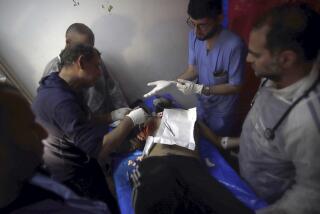Fighting Drives Thousands More From S. Africa Camp
- Share via
CAPE TOWN, South Africa — Conservative black vigilantes, apparently supported by white police and troops, drove thousands more residents of the Crossroads squatter settlement from their homes outside Cape Town on Tuesday in another day of fierce fighting here.
Three-quarters of the sprawling Crossroads settlement, once home to more than 120,000 blacks, has been destroyed in the bitter fighting between the vigilantes and militant black youths over the past month, and nearly 80,000 people are now homeless and destitute on the windy, rain-swept flatlands outside Cape Town.
The official death toll in two days of fighting this week now stands at 17, according to police, but relief workers said the fatalities probably total twice that. Forty-eight people were killed in the first round of fighting last month, and at least 20 more died in the two intervening weeks. Dozens more were reported injured Tuesday, including four newsmen covering the fighting.
Gunfire Echoes
Gunfire echoed throughout Tuesday across the shantytown, most of which had been burned Monday, as the vigilantes--known as Witdoeke from the Afrikaans for the white strips of cloth they use to identify themselves in battle--fought with militant black youths known as the Comrades, the residents of Crossroads’ KTC section, named for a nearby store.
The two sides started massing their forces under cover of the early morning mists Tuesday to resume the battle begun Monday for control of KTC, the last Crossroads section outside the vigilantes’ control and a refuge for thousands who had been burned out of their homes in earlier fighting.
After several probes by each side, police fired repeated volleys of tear gas to clear the Comrades, numbering more than 1,000, from a ridge line from which they were defending KTC. Then more than 2,000 Witdoeke, led by half a dozen police armored cars, attacked and drove the defenders off, pursuing them for two hours through the streets of adjacent black townships.
The air was filled with the Witdoeke’s war cries as they surged forward in their attack, armed with long knives, machetes, spears, iron bars and wooden clubs as well as a large number of rifles and pistols. Mothers, babies on their backs and in their arms, fled with what few possessions they had managed to salvage from their homes. And the Comrades, a few of whom were armed with AK-47 assault rifles and old pistols, fought a rear-guard action as the residents escaped.
So fierce was the fighting when the two groups clashed that skulls were split and arms severed by machete blows. Gunfire, a rarity until now in South Africa’s civil conflict, was almost continuous, and police patrols repeatedly came under attack by gunmen. Scores of firebombs were thrown from large stockpiles the Comrades had prepared overnight.
A two-man television crew, George De’Ath and Andile Fosi, both South Africans working for Britain’s Independent Television News, were attacked by machete-wielding Witdoeke, who had earlier threatened to kill any newsmen they caught. De’Ath suffered serious head wounds and was reported in critical condition. Two other newsmen--a reporter for a South African paper and a French photographer--were wounded by gunfire.
As soon as they had gained the KTC ridge, the Witdoeke used cans of gasoline and small incendiary devices to burn the remains of the wood, plastic and tin shanties at KTC, which have housed more than 50,000 people.
The vigilantes’ brutal conquest of the last Crossroads section held by the Comrades, who support the outlawed African National Congress in its fight against apartheid, was also a major victory for the minority white government in its decade-long effort to move the squatters farther from Cape Town and end their political militancy.
The police again rejected all suggestions that they had backed the vigilantes and said they had ordered both groups to disperse and fired tear gas and birdshot at both when they failed to do so.
But to those on the scene of the battle there was no doubt that the Witdoeke had extensive police support in violation of a court order two weeks ago barring the vigilantes from attacking KTC and requiring the police to prevent them from doing so.
The vigilantes would not have gained control of the strategic KTC camp ridge without the barrage of tear gas grenades from the police and the police armored cars to lead the final Witdoeke assault.
More to Read
Sign up for Essential California
The most important California stories and recommendations in your inbox every morning.
You may occasionally receive promotional content from the Los Angeles Times.










